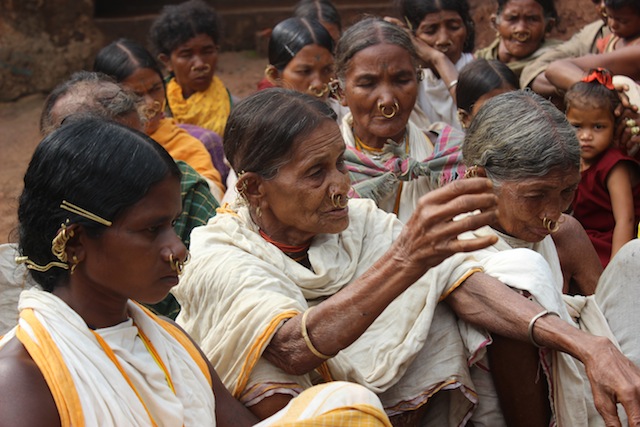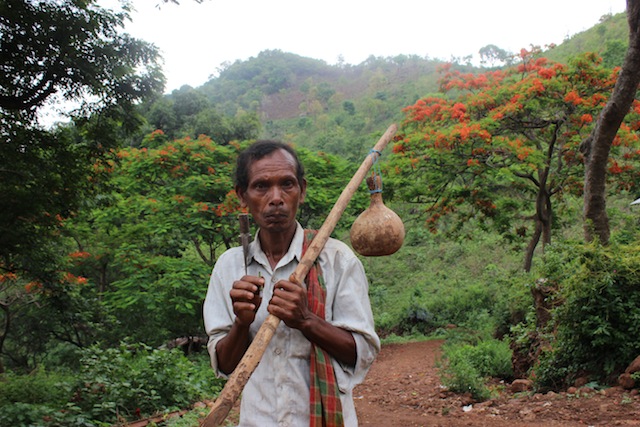
Priestesses from the Dongria Kondh tribal community in the eastern Indian mountain range of Niyamgiri perform an elaborate ritual before setting out on a quest for ancient seeds. Credit: Manipadma Jena/IPS
NIYAMGIRI, India, Jul 22 2015 (IPS) – As the rhythmic thumping of dancing feet reaches a crescendo, the women offer a song to their forest god for a bountiful harvest.
“We are Dongria Kondh. We will die without our sacred hills and seeds.” — a priestess from the Niyamgiri Hills in eastern India
Then, with earthen pots on their heads and their spiritual creatures – a pigeon and a hen – in tow, they proceed in single file on a long march away from their village of Kadaraguma, located on the Niyamgiri mountain range in the Rayagada District of the eastern Indian state of Odisha.
Members of the forest-dwelling Dongria Kondh tribe, who worship these hills as the sacred abode of their god Niyam Raja, these women are priestesses, known in the local dialect as ‘bejuni’.
The ceremony today is the first stage in a journey to a neighbouring village to collect a rare variety of heirloom millet, the traditional staple food source of the 10,000-strong tribe.
The hardy, highly nutritious cereal was once cultivated on massive swathes of farmland throughout India. Here on the Niyamgiri Hills, the Dongria Kondh tribe has long sworn by the benefits of millet and dedicated stretches of the mountainside to its production.
Over the past several decades, however, industrial and extractive development in the resource-rich state has swallowed up many acres of land and pushed the drought-resilient crop to the sidelines.
A government rice subsidy scheme has also contributed to a decline in millet production and consumption, much to the dismay of indigenous communities like the Dongria Kondh who attach not only good health, but also spiritual and cultural value to the local food source.
Determined to preserve it, the priestesses are going door-to-door, from village to village, encouraging their members to revive the unique heritage.
An intricate ritual
“As a girl, I heard that we harvested over 30 traditional varieties of millet,” 68-year-old Dasara Kadraka, the senior-most priestess from the 22 villages working together on millet preservation, tells IPS. “Ten years ago, that was down to 11 varieties and today, only two varieties are grown.”
Dasara hails from Kadaraguma, a village comprised of 31 households that is playing a key role in the project.
Above it, in high-reach hamlets of the hills that can only be reached by foot and located a good 15 km from Kadaraguna, smaller village communities have already preserved several dying varieties of the plant including one called ‘kodo’ millet, a high-fibre variation that is ideal for treating diabetes.
Seed collection follows an intricate ritual. Traveling by foot, a group of priestesses visit villages where they have been told an ancient millet variety is being preserved. Offering the hen and the pigeon to the local bejuni, the seed savers then request four measures of the seeds – enough to fill four bamboo baskets – to be poured into a white cloth.

Dasara Kadraka, the senior-most priestess from the 22 villages that are working together to revive millet varieties in the Indian state of Odisha, explains why the tribe embarked on their initiative. Credit: Manipadma Jena/IPS
The seed is then distributed equally among five families in the traveling priestesses’ village, to be sown during the month of June. Rain-fed, the crop delivers a harvest in December that is on average 50 times the quantity of seed planted.
In payment, the priestesses deliver eight basketsful of grain to their neighbours – double the amount of seed they received.
News of rare seed varieties travels by word of mouth, with the members of the Dom community – a primarily Dalit tribe who have lived for centuries as neighbours with the Dongria Kondh people – acting as messengers.
Visits by Dom community members to far-flung, remote hamlets recently yielded reports on two ‘vanishing’ millet species: the ‘khidi janha’, a close relation of sorghum, in Jangojodi village; and a version of the foxtail millet, called ‘kanga-arka’, in Sagadi village.
The more people hear of these stories, the more involved the entire community becomes. Whenever they meet, during village rituals or at the weekly market, bejuni networks eagerly inquire about news of revived seeds.
When major clans of the Dongria Kondh tribe – who are spread across some 120 villages on the Niyamgiri Hills – get together for marriages or clan feasts, the first question is if a family is preserving a millet variety that others have abandoned.
Local habits, wholesome diets
In 2013, Dongria Kondh people made front page news all around the world when their determined opposition to a British mining company’s bauxite extraction operation on the revered mountain range resulted in the private multinational’s departure from Niyamgiri.
In chasing away the mining giant, the tribe showed the same reverence for this ancient land as it now displays in its efforts to protect an old agricultural custom.
Sixty years ago millet was grown in 40 percent of all cereal cultivated areas in India, a figure that has today fallen to just 11 percent of the country’s harvested land.
Data from the Food and Agricultural Organisation (FAO) of the United Nations reveals that while millet production was rising steadily 20 years ago, it began to fall again at the turn of the millennium, with production levels in 2010 barely exceeding those of 1990.
In Niyamgiri, the numbers are even starker. “A government scheme to promote cash crops like pineapple, turmeric and ginger among the Dongria Kondh community has cut into 50 percent of millet land over the past fifteen years,” Susanta Kumar Dalai, a social sector volunteer who has worked closely with the Dongria Kondh tribe, tells IPS.
Given that the crop grows well in adverse settings, able to thrive in drought-like conditions and requiring no irrigation beyond what the seasonal rains can provide, rural communities have been at a loss to explain the government’s decision to reign in its production.
Millet also adds high amounts of protein, vitamin B and minerals such as magnesium, potassium, zinc and copper to the simple diets of tribal people, filling crucial nutritional gaps that cannot be supplemented with other, costlier foods.
in the community is common, seen in six out of 10 school-age children, while 55 percent of adults show chronic energy deficiencies.

Millet gruel is carried in natural gourd containers that maintain an even temperature, even under the sun. Credit: Manipadma Jena/IPS
Extreme hunger in Niyamgiri – measured according to the government’s benchmark of a daily intake of 2,400 calories – stands at 83 percent.
None of the Dongria Kondh villages have access to electricity, sanitation or safe drinking water facilities. While this seldom interferes with their traditional lifestyle, it does present severe challenges in terms of healthcare.
Communities mostly rely on traditional medicines sourced directly from their ancestral forests, but more serious and ‘modern’ epidemics – such as chronic diarrhoea or other water-borne diseases – call for advanced medical interventions.
These are not easily accessible, with primary health facilities located anywhere from one to 22 km from the remote villages. Often, these centres are reachable only by foot, with the sick transported in makeshift hammocks or ‘rope cots’.
Too frequently, the journeys are fatal. The situation is made worse by the fact that many tribe members – including the elderly – are forced to navigate steep terrain in order to reach government services, neighbouring villages or even farmlands.
Locals tell IPS that falling back on traditional farming practices like mixed cropping and old dietary habits could solve many of these problems.
“When we had more millet varieties we would sow up to nine different cereals and lentils in a single patch,” explains 53-year-old Krusna Kadraka, headman of Kadaraguma village.
At harvest time every house would have several overflowing ‘guli’ – cow dung-coated bamboo baskets able to hold up to 200 kg of grain.
Now, as cereal varieties vanish, replaced by mono-crops like rice, 27 out of 31 households in this village who each own a hectare of hilly farmland harvest barely two guli of grain annually.
The ‘grain caste system’
Mankombu Sambasivan Swaminathan, a prominent 88-year-old geneticist, tells IPS that India has developed a ‘grain hierarchy’, with white rice – a money-maker for industrialists in the business of selling fertilizer and a major export-earner for the government – considered superior to more traditional crops.
Related IPS Articles
At Swaminathan’s insistence, millet will soon be included in the country’s public food distribution system, a massive state programme that promises subsidised grain to two-thirds of India’s population of 1.2 billion – essentially feeding 820 million people.
While the scheme is , it has reached millions of families, converting large rural populations into rice consumers and positing millet as a “coarse” grain, destined to become fodder for livestock rather than a dietary staple for humans.
Swaminathan tells IPS he is urging not only the Indian government to recognize the value of millet, but also the United Nations to name an international year after what he calls the “orphan crop” – one that was once popular around the world but has largely been forsaken in an increasingly globalised, export-driven food system.
Such a move could be just what the doctor ordered for a country that has one of the highest rates of hunger in the world, with 194.6 million people defined as ‘undernourished’ by the FAO, putting it ahead of neighbouring China in both absolute and relative terms.
The World Health Organisation (WHO) also estimates that close to 1.3 million children die every year in India because of malnutrition, while the country’s prevalence of underweight kids is nearly double that of sub-Saharan Africa.
While the matter is being debated at the highest level of politics, communities here on the sloping hillsides in eastern India are already setting processes in motion that could make the region nutritionally self-sufficient.
Forty-year-old resident Gulpa Kadraka tells IPS that he tried replacing his millet gruel with rice, but found it did not sustain him as he climbed steep hills and crossed streams to reach his farmland. “It never gave me the energy that millet does,” he explains.
Like many of his community members, he is invested in the attempt to preserve the old agricultural ways and eating habits. Others feel that the millet revival scheme will deter corporations, and particularly mining companies, who still have their eye on these lucrative hills.

A group of priestesses discuss their plans before setting off in search of ‘vanishing’ millet varieties from a neighbouring village in eastern India. Credit: Manipadma Jena/IPS
Kone Wadaka, a 64-year-old priestess, tells IPS, “Even though we chased away Vedanta [the British mining company], we are still afraid it will come back to take away our hills, our streams and our hillside farms.
“We will not be able to grow millet on the plains where the company wanted to re-settle us. Also, on lowland areas we will not have access to the forests’ yams, the edible leaves and all the fruits on our sacred hills that are untouched by chemical pesticides and fertilizers,” she adds.
By rekindling their old traditions, and re-planting large sections of the hills with millet, the community feels they will be sending a strong signal to any potential intruders who see the tribe merely as an obstacle to the extraction of natural wealth, rather than a permanent fixture in Niyamgiri’s ecosystem.
“We are Dongria Kondh,” another priestess tells IPS. “We will die without our sacred hills and seeds.”
Edited by
This article is part of a special series entitled ‘The Future Is Now: Inside the World’s Most Sustainable Communities’. Read the other articles in the series